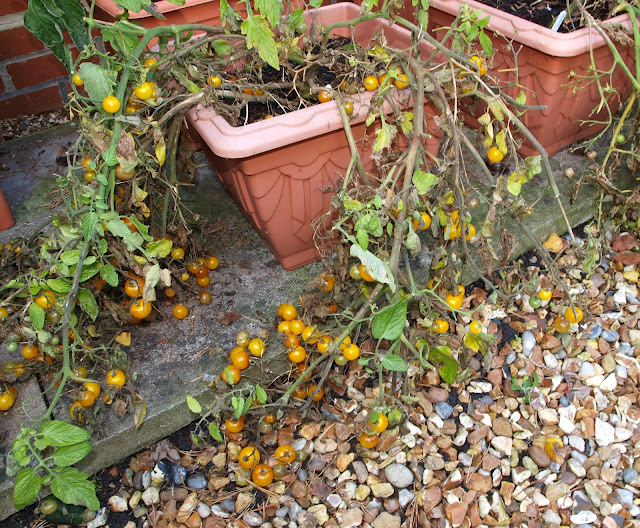Since blight is an air-borne disease the best way to avoid blight affecting your plants is of course to grow them in a greenhouse, but if that is not an option, some people erect a temporary frame to support plastic sheeting over the plants, which is apparently reasonably effective.
The advent of blight is normally associated with warm, moist conditions, so in the UK it typically appears in late July or August. This year we have got away with it until quite late (probably because our Summer was a lot cooler than normal), and none of my potatoes were hit, but I regret to report that many of my tomato plants are now affected.
The tell-tale signs are these: brown mouldy patches on the leaves
Brown or blackened stems
Fruits that initially go a sort of shiny bronze colour, and then brown and wrinkly
And then the whole plant collapses
Once the signs of blight appear, there is not much you can do. You can cut off the worst-affected bits of your plant, which will help, but it won't be a cure. I usually pick immediately any fruits that are even remotely ripe, and ripen them indoors (keeping a close eye on them to see if they start going brown). By this late stage of the season, tomatoes actually ripen better indoors than out.
It is advisable not to put any blight-infected fruit or foliage in your compost bin, because unless the compost gets very hot the fungal spores will not be killed. I usually put my debris in a strong plastic bag (e.g. the type of bag in which I buy commercial compost), and then take it to the local Tip (Domestic Waste Facility).
Taking the photos with which to illustrate this post, I realised that even a bowlful of blighted tomatoes can be an object of "beauty"... I like the light and shade effects on this one:
***********************************************************************************
P.S. Here's something to cheer you up if your tomatoes have been struck by blight --- these are pictures of the Lasagne that Jane made last night. I think you'll agree that it looks good. It tasted good too!









Nooo poor tomatoes. Im paranoid about mine, but I seem to be having beginners luck at the moment.
ReplyDeleteOh the lasagne looks lovely, makes me want one now :p
Heard about it but never had it. I guess we are just too dry all the time in the summer.
ReplyDeleteThe lasagna looks wonderful!
Oh the power of suggestion - If I hadn't already put a chook in the oven we'd be having lasagna tonight - that looks great. Tomorrow! Thanks for the info on blight - now I know what to look out for - hopefully without finding it.
ReplyDeleteNot had the blight here either. The tomatoes are nearly done. Nice looking lasagna!
ReplyDeleteGrowing in a greenhouse isn't a fail safe though.
ReplyDeleteOn the plot we have had blight affect tomatoes inside the greenhouse - you can't usually keep the door shut all summer and the spores seem to find a way in!
I sympathise Mark the same happened to me, though the greenhouse toms seem to be OK.
ReplyDeleteVery sorry to hear about your blight affected tomatoes. But you've got great pictures in spite of the problem at hand. Thank you for this informative post on blight.
ReplyDelete